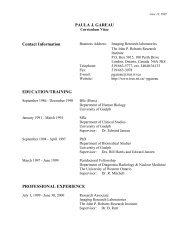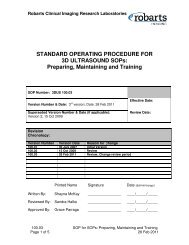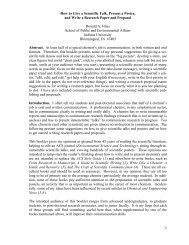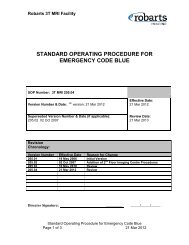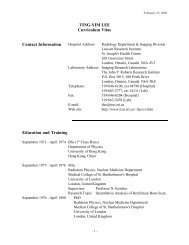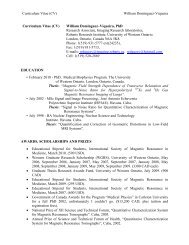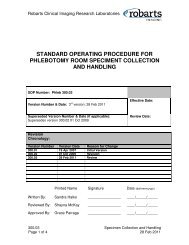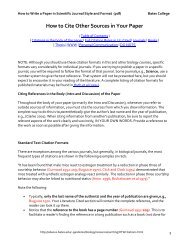how to read a scientific [journal] article - Robarts Imaging
how to read a scientific [journal] article - Robarts Imaging
how to read a scientific [journal] article - Robarts Imaging
- No tags were found...
You also want an ePaper? Increase the reach of your titles
YUMPU automatically turns print PDFs into web optimized ePapers that Google loves.
Literature Cited sections go hand-in-hand. Most importantly, within the first paragraph or 2of the Introduction the authors should have made it very clear what their objectives for theresearch were, and what their paper will tell you.6. Check <strong>to</strong> see if the Results adequately and accurately describe the data presented in the paper.Are there additional points that should have been brought up? Is there something in thefigures or tables that does not substantiate the authors' claims that was not mentioned? Do thefigures and tables clearly, succinctly, and attractively present the results of the paper?Remember that great data presented clumsily or sloppily will not be seen as great, onlyclumsy or sloppy.7. Now <strong>read</strong> the Discussion. This is perhaps the most important section, because it is here thatthe results (the "what" of the research) are explained. That is, here is where the authors should[at least try <strong>to</strong>] explain "why" they saw what they saw. Beware of unsubstantiatedspeculation, though do not fault, off-hand, the presentation of hypotheses for future work oreven expectations of findings from those future experiments. On the other hand, there areauthors who are prone <strong>to</strong> timidity, understatement, or who are just plain invertebrate abouttheir ideas. You should not be left guessing, or left <strong>to</strong> fumble <strong>to</strong> your own conclusionsbecause an author was unwilling <strong>to</strong> take even a small step out on<strong>to</strong> a limb. As a moderateexample of such understated conclusions, Watson and Crick ended their his<strong>to</strong>ric presentationof the structure of DNA with the sentence: "It has not escaped our notice that the specificpairing we have postulated immediately suggests a possible copying mechanism for thegenetic material." In fact, the complimentary base pairing they presented was no less that aquantum leap in our understanding of biological systems, in terms of both modernbiochemistry and evolution!Bear in mind that the ultimate burden of assessing published material lies with you, the<strong>read</strong>er. Take the time and energy <strong>to</strong> do this and you will gain more and be further along that theperson who depends on the author for interpretation. Having just completed a critical <strong>read</strong>ingand assimilation of a <strong>journal</strong> <strong>article</strong> pertinent <strong>to</strong> your work, you should be able <strong>to</strong> paraphrase thesignificance of this paper with 3 or 4 sentences free of technical jargon. You should also be able<strong>to</strong> both praise and criticize several points of the paper (this is important--see note below). Ageneral rule of thumb, regarding what goes where, when both <strong>read</strong>ing and writing a <strong>scientific</strong><strong>article</strong> is:Title: Short, succinct, eye-catching, all-encompassingAbstract: Summary of Methods, Results, and Discussion starting off with a statement of why theresearch was done and with emphasis on why the results are significant.Introduction: When was past work done, by whom, why was their work important, what youplan <strong>to</strong> do in your paper, and why what you did is important.Materials and Methods: How you did what you did and where you did it--nothing more.Results: What the data s<strong>how</strong> you--nothing more.Discussion: Why the data s<strong>how</strong> what they s<strong>how</strong>, and <strong>how</strong> your analysis relates back <strong>to</strong> yourobjectives from the Introduction.Note: Some <strong>journal</strong>s will allow the Results and Discussion sections <strong>to</strong> be combined. In thiscase, the data should be divided up in<strong>to</strong> logical groups, and for each group (generallyseparated by a subheading) the What and the why are presented <strong>to</strong>gether.


![how to read a scientific [journal] article - Robarts Imaging](https://img.yumpu.com/44345644/2/500x640/how-to-read-a-scientific-journal-article-robarts-imaging.jpg)

